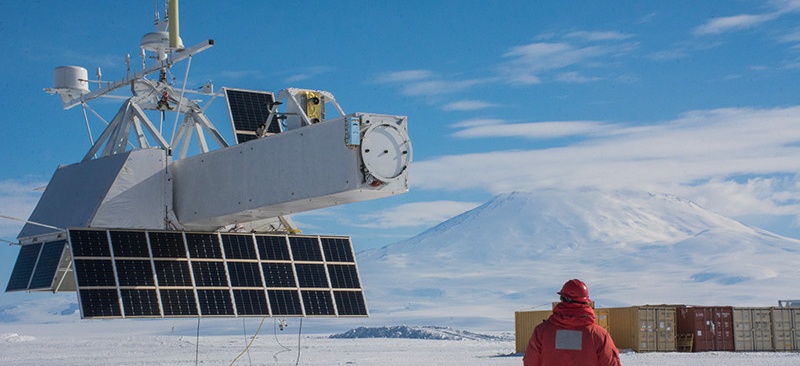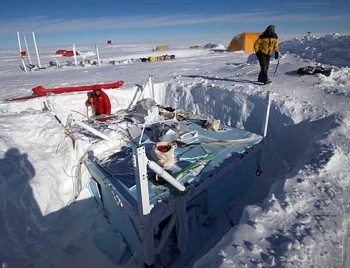News Archive 2016
-
November, 23 2016
GRIPS recovery in Antarctica
McMurdo Station, Antarctica.- Next week, Drs. Hazel Bein and Nicole Duncan, scientists of the Space Sciences Laboratory (SSL) of the University of California, Berkeley will arrive to Antarctica to perform the recovery of the remains of their experiment which was launched in a balloon from McMurdo station, early this year.
The experiment, denominated GRIPS (Gamma-Ray Imager/Polarimeter for Solar flares) was born by a collaboration that includes the aforementioned SSL along with NASA's Goddard Space Flight Center; The Lawrence Berkeley National Laboratory; the University of California, Santa Cruz and the Nagoya University from Japan. Below these lines we can see an image of the instrument with a magnificent view in the background of Erebus mount.

The main goal of GRIPS was to provide high-resolution imaging, spectroscopy, and polarimetry of solar-flare gamma-ray/hard X-ray emissions in the range of energies between ~20 keV to >~10 MeV. GRIPS data will help the scientific community to answer several questions like what causes the spatial separation between energetic electrons producing hard X-rays and energetic ions producing gamma-ray lines, how anisotropic are the relativistic electrons, and why can they dominate in the solar corona or how do the compositions of accelerated and ambient material vary with space and time.

GRIPS was launched by NASA on a stratospheric balloon on January 19, from the Williams Field airport and landed on January 30 in a place located at coordinates 83°6.18 S - 40°54.08 W, east of Pensacola Mountains, in Antarctica, after a trip of 11 days and 19 hours, around the pole. At right we can see the flight path.
The late date of the launch, (which according to our records was the latest launch performed by NASA in an Antarctic campaign since the inception of the program in 1989), forced to make merely a quick recovery trip to the landing site to extract the data vaults onboard the instrument. The rest of the structure, rested for almost a year in the Antarctic plateau. The late date of launch and termination forced to delay the rescue operations of the instrument to this campaign. The reason: the priority of the scarce available planes in the white continent is to perform the retrograde operations of evacuating personnel from bases at the season's end.
Recovery in extreme conditions
Aside the problems generated by the extreme environment for the launch of the balloons, the recovery of the payload after the flight is the most difficult part of this kind of operations in Antarctica.
Depending on the place on which the payload lands, the mission could turn a very complex one. If the altitude of the landing is high, to the natural difficulty of the task must be added the need to use oxygen to work on the field. Also the distance from the nearest base or the condition of the terrain are factors to be considered. Many times an advanced team is deployed on a small plane a few days before the rescue begins, simply to prepare the terrain for the landing of the aircraft which will transport the payload parts. Also, to cover the long distances across the ice, many times is necessary to drop fuel caches along the route.

Against all odds, NASA with the support of the National Science Foundation have a very good record on payload recoveries in the white continent.
As an example, in 2012, a cosmic ray experiment called SuperTIGER also launched by NASA in a balloon was left on its remote landing spot two years, before being recovered. As we can see in the image at left, after two winters, the instrument was almost completelly buried in snow. The epic adventure which was published in the Antarctic Sun, is certainly worth reading to assess the true dimension of the task.
However, aside some incidents with gondolas which were dragged by the wind across the rugged surface in remote places and suffered considerable damage, there is only one incident on which a payload was lost in Antarctica. It occured in 1993 with the JACEE 11 mission: after the flight was completed and when the balloon was in the vicinity of McMurdo after a full circle to the pole, the termination system failed, so it was decided to bring down the balloon valving the helium inside it. However, by the time when the balloon reached ground level it had drifted away from the planned landing location and cleared the sea shore. As a result, the payload crashed through the ice and sunk only one quarter mile offshore of Ross Island. Attempts to dredge the gondola were made in the next days, and even in following season to no avail. More details on this can be read in my report of the mission.
Back to GRIPS recovery, if the team is able to obtain internet access while deployed, they will be informing about the ongoings of the operation via the @GRIPSballoon twitter account.
-
Share this on social media


